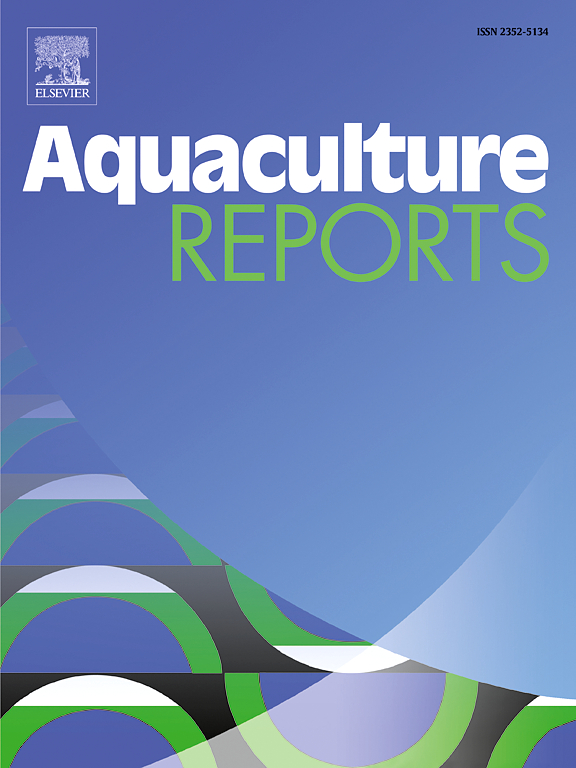Effects of different protein and lipid levels on the growth performance, intestinal health and intestinal microflora of pikeperch (Sander lucioperca) juvenile
IF 3.2
2区 农林科学
Q1 FISHERIES
引用次数: 0
Abstract
A 2 × 3 factorial (protein: 51 %, 54 %; lipid: 12 %, 15 %, 18 %) experiment was conducted to investigate the effects of feed protein and lipid levels on growth, intestinal health, and intestinal microflora of the pikeperch juvenile. During the 8-week experiment, the 2700 pikeperch (1.00 ± 0.15 g) were chosen and randomly divided into six treatments with three replicates in each treatment. At the 51 % protein level, pikeperch juvenile exhibited optimal growth performance at the 18 % lipid level. The expression levels of il-1β and tnf-β in intestine were increased, meanwhile the expression levels of il10 and tgf-β were decreased with the increase of dietary lipid level. Intestinal barrier function was also affected by dietary lipid levels, the expression levels of occludin-a, occludin-b, and zo-2 increased with the increase of dietary lipid level. Additionally, the abundance of Leuconostoc, Pediococcus, and Lactococcus increased with increasing dietary lipid level. At the 54 % protein level, pikeperch juvenile achieved optimal growth performance at the 15 % lipid level. The expression of il-1β and tnf-β was lowest, meanwhile il10 and tgf-β expression was highest at the 15 % lipid level, significantly exceeding that of the 18 % lipid group. The expression of occludin-a decreased with increasing lipid levels, while occludin-b and zo-2 expression was highest at the 15 % lipid level. Intestinal microflora analysis indicated that at the 15 % lipid level, the abundance of Leuconostoc, Pediococcus, Lactococcus was greatest. When the protein level of the feed was 51 % and the lipid level was 18 %, the growth performance of juvenile pikeperch was the best, and there was no obvious tissue damage or inflammatory response. The structure of the intestinal microflora was also relatively stable, indicating that the optimal protein and lipid levels for juvenile pikeperch were 51 % and 18 %, respectively.
不同蛋白质和脂肪水平对粉红鲈幼鱼生长性能、肠道健康和肠道菌群的影响
A 2 × 3 !(蛋白:51 %,54 %;本试验旨在研究饲料蛋白质和脂肪水平对粉红鲈幼鱼生长、肠道健康和肠道菌群的影响。试验8周,选取1.00 ± 0.15 g的鼠鲈2700只,随机分为6个处理,每个处理3个重复。在51 %蛋白质水平下,18 %脂肪水平下鲈鱼幼鱼的生长性能最佳。随着饲粮脂肪水平的升高,肠道il-1β和tnf-β表达水平升高,il- 10和tgf-β表达水平降低。肠道屏障功能也受饲料脂肪水平的影响,occludin-a、occludin-b和zo-2的表达水平随着饲料脂肪水平的升高而升高。此外,随着饲料脂肪水平的增加,白球菌、Pediococcus和乳球菌的丰度也增加。在蛋白质含量为54% %时,脂肪含量为15% %时,鲈鱼幼鱼的生长性能最佳。il-1β和tnf-β的表达在15 %脂质组最低,il- 10和tgf-β的表达在15 %脂质组最高,显著高于18 %脂质组。occludin-a的表达随着脂质水平的升高而降低,occludin-b和zo-2的表达在15% %脂质水平时最高。肠道菌群分析表明,在15 %脂质水平下,Leuconostoc、Pediococcus、Lactococcus丰度最大。饲料中蛋白质水平为51 %,脂肪水平为18 %时,鲈鱼幼鱼的生长性能最好,无明显的组织损伤和炎症反应。肠道菌群结构也相对稳定,表明鲈鱼幼鱼的最佳蛋白质和脂肪水平分别为51 %和18 %。
本文章由计算机程序翻译,如有差异,请以英文原文为准。
求助全文
约1分钟内获得全文
求助全文
来源期刊

Aquaculture Reports
Agricultural and Biological Sciences-Animal Science and Zoology
CiteScore
5.90
自引率
8.10%
发文量
469
审稿时长
77 days
期刊介绍:
Aquaculture Reports will publish original research papers and reviews documenting outstanding science with a regional context and focus, answering the need for high quality information on novel species, systems and regions in emerging areas of aquaculture research and development, such as integrated multi-trophic aquaculture, urban aquaculture, ornamental, unfed aquaculture, offshore aquaculture and others. Papers having industry research as priority and encompassing product development research or current industry practice are encouraged.
 求助内容:
求助内容: 应助结果提醒方式:
应助结果提醒方式:


